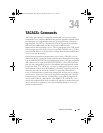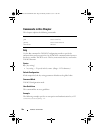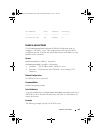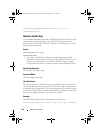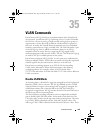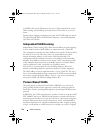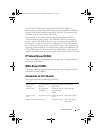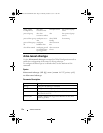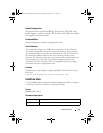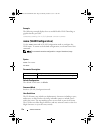
VLAN Commands 769
35
VLAN Commands
PowerConnect 802.1Q VLANs are an implementation of the Virtual Local
Area Network, specification 802.1Q. Operating at Layer 2 of the OSI model,
the VLAN is a means of parsing a single network into logical user groups or
organizations as if they physically resided on a dedicated LAN segment of
their own. In reality, this virtually defined community may have individual
members scattered across a large, extended LAN. The VLAN identifier is part
of the 802.1Q tag, which is added to an Ethernet frame by an 802.1Q-
compliant switch or router. Devices recognizing 802.1Q-tagged frames
maintain appropriate tables to track VLANs. The first 3 bits of the 802.1Q tag
are used by 802.1p to establish priority for the packet.
PowerConnect supports 802.1Q VLANs. As such, ports may simultaneously
belong to multiple VLANs. VLANs allow a network to be logically segmented
without regard to the physical locations of devices in the network.
PowerConnect switching supports up to 1024 VLANs for forwarding.
VLANs can be allocated by subnet and netmask pairs, thus allowing
overlapping subnets. For example, subnet 10.10.128.0 with Mask
255.255.128.0 and subnet 10.10.0.0 with Mask 255.255.0.0 can have different
VLAN associations.
Double VLAN Mode
An incoming frame is identified as tagged or untagged based on Tag Protocol
Identifier (TPID) value it contains. The 802.1Q standard specifies a TPID
value (0x8100) to recognize an incoming frame as tagged or untagged. Any
valid Ethernet frame with a value 0x8100 in the 12th and 13th bytes is
recognized as tagged frame. 802.1Q switches check the 12th and 13th bytes to
decide the tag status of incoming frame.
The PowerConnect switching component can be configured to enable the
port in double-VLAN (DVLAN) mode. In this mode switch looks for 12th,
13th, 16th, and 17th bytes for the tag status in the incoming frame. The outer
tag (S-TAG) TPID is identified with the 12th and 13th bytes values. The
inner tag (C-TAG) TPID is identified with 16th and 17th bytes values. These
2CSPC4.XCT-SWUM2XX1.book Page 769 Monday, October 3, 2011 11:05 AM



